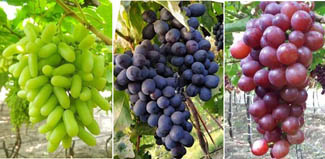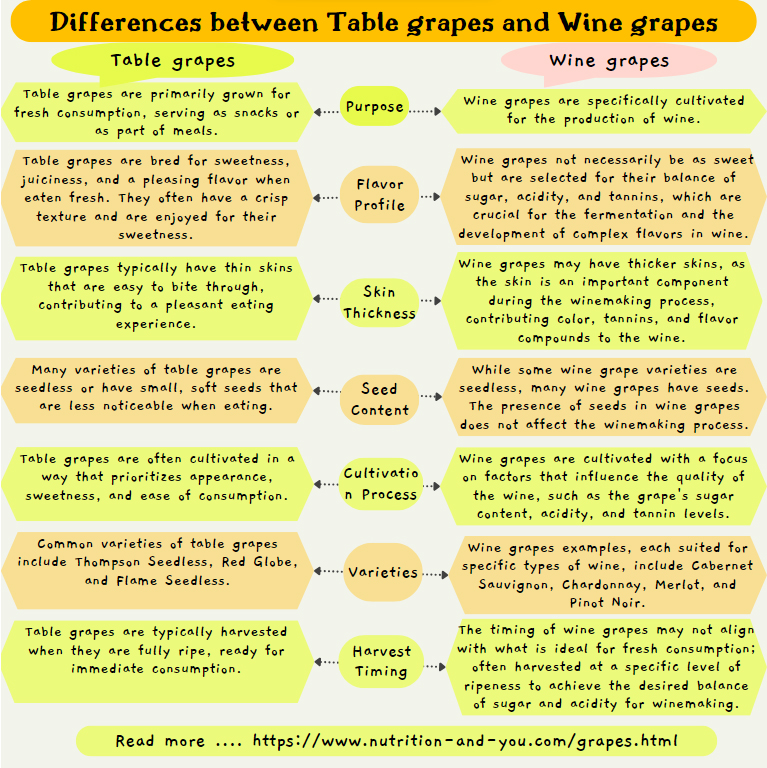Grapes nutrition facts
One of the most popular among the regularly featuring table fruits, grapes are widely considered the "Queen of fruits" since earlier times for their wholesome nutritional qualities.
These tiny berries of European and Mediterranean origin are the storehouse of numerous health-promoting phytonutrients such as polyphenolic antioxidants, vitamins, and minerals. No wonder why we fond of them in our diet; be it as fresh table fruits, dry fruits (raisins), juice, or simply in salads!
Botanically, they are small, round berries growing in clusters on a perennial and deciduous woody vine of the genus, Vitis. Today, they are widely cultivated under supervised orchards and vineyards all around the world.
 |
| White/green, Blue/black, and Red/purple cultivar types. |
In structure, each grape berry features semi-translucent flesh encased inside a smooth, thin skin. Some varieties contain edible seeds, while others are seedless. The color of the berries is because of the presence of polyphenolic pigments in them. Red or purple berries are rich in anthocyanins while white-green berries compose more tannins, especially, catechin. Interestingly, these antioxidant compounds are concentrated densely in the skin and seeds!
The three most important species of table-grapes grown around the world are; European (Vitis vinifera), North American (Vitis labrusca, and Vitis rotundifolia), and French hybrids.
Some of the popular green cultivars are Thompson seedless, sugarone, and calmeria.
Red varieties include emperor, red globe, cardinal, and flame seedless.
Concord and zinfandel are some of the flavorful blue-black cultivars.
Commercially, many cultivars of grapes are grown for different purposes either to be eaten as table fruit, fresh or dried (raisin, currant, sultana) or in wine production :See the differences between Table-grapes and Wine-grapes in an infographic.
 |
7 Amazing Health Benefits of Grapes
Grapes are rich in polyphenolic phytochemical compound resveratrol. Resveratrol is one of the powerful anti-oxidants that has been found to play a protective role against cancers of the colon and prostate, coronary heart disease (CHD), degenerative nerve disease, Alzheimer's disease, and viral/ fungal infections.
Resveratrolreduces stroke risk by altering the molecular mechanisms inside the blood vessels. It does so, firstly by reducing the susceptibility of the blood vessel through decreased activity of angiotensin (a systemic hormone causing blood vessel constriction that would otherwise elevate blood pressure) and secondly, through increased production of vasodilator substance, nitric oxide (a beneficial compound that causes relaxation of blood vessels).
Anthocyanins are another class of polyphenolic antioxidants present abundantly in red grapes. These phytochemicals have been found to have an anti-allergic, anti-inflammatory, anti-microbial, as well as anti-cancer activity.
Catechins, a type of flavonoid tannin group of anti-oxidants, discovered in the white/green varieties have also been shown to possess these health-protective functions.
Also, the berries are very low in calories. 100 g fresh grapes just provide 69 calories but zero cholesterol levels.
Grapes are a rich source of micronutrient minerals like copper, iron, and manganese. Copper and manganese are essential cofactors of the antioxidant enzyme, superoxide dismutase. Iron is especially concentrated in raisins. Besides, 100 g of fresh grapes contain about 191 mg of health-benefiting electrolyte, potassium.
They are also a good source of vitamin-C, vitamin-A, vitamin-K, carotenes, B-complex vitamins such as pyridoxine, riboflavin, and thiamin.
| Principle | Nutrient Value | Percent of RDA |
|---|---|---|
| Energy | 69 Kcal | 3.5% |
| Carbohydrates | 18 g | 14% |
| Protein | 0.72 g | 1% |
| Total Fat | 0.16 g | 0.5% |
| Cholesterol | 0 mg | 0% |
| Dietary Fiber | 0.9 g | 2% |
| Vitamins | ||
| Folates | 2 µg | 0.5% |
| Niacin | 0.188 mg | 1% |
| Pantothenic acid | 0.050 mg | 1% |
| Pyridoxine | 0.086 mg | 7.5% |
| Riboflavin | 0.070 mg | 5% |
| Thiamin | 0.069 mg | 6% |
| Vitamin-A | 66 IU | 3% |
| Vitamin-C | 10.8 mg | 18% |
| Vitamin E | 0.19 mg | 1% |
| Vitamin K | 14.6 µg | 12% |
| Electrolytes | ||
| Sodium | 0% | 1 mg |
| Potassium | 191 mg | 4% |
| Minerals | ||
| Calcium | 10 mg | 1% |
| Copper | 0.127 mg | 14% |
| Iron | 0.36 mg | 4.5% |
| Magnesium | 7 mg | 2% |
| Manganese | 0.071 mg | 3% |
| Zinc | 0.07 mg | 0.5% |
| Phyto-nutrients | ||
| Carotene-α | 1 µg | -- |
| Carotene-ß | 39 µg | -- |
| Crypto-xanthin-ß | 0 µg | -- |
| Lutein-zeaxanthin | 72 µg | -- |
Selection and storage
Fresh table-grapes can be available all around the seasons. In the stores, choose those that feature plump in texture, free from surface wrinkles with intact skin, without any cuts or cracks or leaking juice, and firmly attached to a healthy-looking green stem. Lift up the whole bunch in the air and shake gently; loose berries, if any fall off easily.
Buy exactly ripe berries; green grapes should feature a slight yellowish hue; red types should be mostly pinkish-red, while purple and blue-black types should be profound and rich in color.
Since grapes tend to spoil early and ferment at room temperature, they should always be stored in the refrigerator. Loosely wrap washed berries in a paper towel and place them in a zip pouch bag set at high relative humidity. This way, they will keep fresh in the refrigerator for a few days.
Preparation and serving method
Just before eating, wash the whole bunch to remove any pesticide residues and dirt by rinsing in cold water for a couple of minutes. Place them in fresh cold water and gently swish them around a few times. Pat dry using a soft cloth.
If you are not going to consume the whole bunch in one go, then separate it into small clusters using scissors. This way, you can keep the remaining berries fresher by preventing their stem from drying out.
Although its seeds are rich in nutrients, seedless grapes make the recipes much more pleasant to eat.
Here are some serving tips;
Enjoy them as they are, without any seasonings/additions.
Add seedless berries to complement any fruit/vegetable salads in peaches, pears, tomato, lettuce, apricot, berries, currants, apple, pineapple, etc.
Dry grapes (raisin, currant, and sultana) are being used in confectionery, puddings, cakes, muffins, bread, etc.
The food industry also uses them in the preparation of jams, jellies, juice, and wine (wine-cultivars).
Also read on- ≻≻-Muscadines Nutrition facts and Health benefits.
≻≻-Raisins Nutrition facts and Health benefits.
≻≻-Back to Fruits from Grapes. Visit here for an impressive list of all varieties of fruits with complete illustrations of their nutrition facts and health benefits.
≻≻-Back to Home page.
Further reading and Resources:
Indian Council of Medical Research- Good agricultural practices for production of quality table grapes.
Refer Stanford School of MedicineCancer information Page- Nutrition to Reduce Cancer Risk. (Opens in new window).